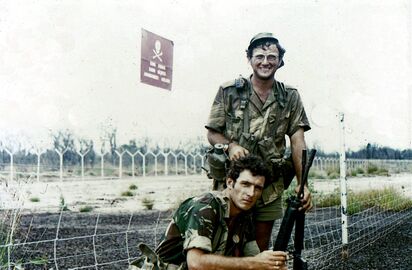Родезийская особая воздушная служба
Материал из ВикиВоины
Родезийская особая воздушная служба (англ. Rhodesian Special Air Service (Rhodesian SAS)) — специальное подразделение вооружённых сил Родезии. В это понятие входит:
- Эскадрон C полка SAS (1951-1953);
- Эскадрон C (Родезийского) SAS (1961-1978);
- 1-й полк (Родезийского) SAS (1978-1980).
Эскадрон C полка Особой Воздушной службы был сформирован в 1951 году во время чрезвычайной ситуации в Малайе из родезийских добровольцев. Расформирован в 1953 году и в 1961 году создан основой для эскадрон C (Родезийского) SAS. В июне 1978 года переформирован в 1-й полк (Родезийского) SAS, и перестал существовать после в 1980 году вместе со страной.
История[править]
Во время Малайской операции (1951-1953 гг.), группа добровольцев из Южной Родезии вызвалась отправиться в Малайю и изначально были известны как "Группа дальневосточных добровольцев" (англ. The Far East Volunteer Group), а позже "Mалайские Скауты" (англ. Malayan Scouts). Находясь в Малайе, эскадрон "C" ("Mалайские Скауты") стал подразделением на ровне с британскими эскадронами "A" и "B" SAS. После завершения службы были отправлены домой и расформированы.
Переформирование[править]
В ноябре 1959 года Федеральное собрание принято решение сформировать "Отряд Оценки Парашютистов" (англ. Parachute Evaluation Detachment (PED)) для изучения практических аспектов военного парашютизма и парашютной подготовки в Федерации Родезии и Ньясаленда, с целью возможного создания воздушно-десантной части. Об этом объявил тогдашний федеральный министр обороны Джон Мур Калдикотт, но именно сэр Рой Веленски был движущей силой реформирования того, что должно было стать "Родезийский САС".
В 1960 году прибыл отряд Королевских ВВС под командованием командира эскадрона Э. Минтера для проведения тренировок "Отряда Оценки Парашютистов" (PED). К марту 1960 года отряд был готов и был взять под патронаж вышеупомянутого министра обороны. "Эксперимент" удался, и в июле было принято решение сформировать регулярную "Европейский Эскадрон Особой Воздушной Службы" (European Special Air Services Squadron). В конце 1960 года было сформировано "учебное подразделение № 1" (No 1 Training Unit), и после завершения обучения будут созданы — 1-й батальон Родезийской лёгкой пехоты (1RLI) и эскадрон "C" САС.
In early 1961 six volunteers from the Air Force were sent to RAF Abingdon in England for parachute instructor training and a further group of volunteer officers and NCOs to complete a selection course with the SAS in Britain. On their return, they called for volunteers from No. 1 Training Unit and in August 1961 the first of many selection courses was run in the Matopos just outside Bulawayo. No 1 basic training course completed their training in November and were presented their wings by Sir Malcolm Barrow, CBE, MP and then Deputy Prime Minister.
In late 1961 the SAS were moved to Ndola Barracks, Ndola in Northern Rhodesia along with the Selous Scouts Armoured Car Regiment. By July the following year, No 9 basic course received their wings from the Federal Prime Minister himself, Sir Roy Welensky, KCMG, MP. In August 1962, the Unit had sufficient men to become operational and became known as "C" Squadron (Rhodesian) Special Air Service.
With the breakup of the Federation at the end of 1963, the Squadron was virtually destroyed by many taking the "golden handshake" and some remaining in Northern Rhodesia which included all the officers and the OC at that time. Only 38 NCOs and men remained to serve in Southern Rhodesia. The Unit was relocated to Cranborne Barracks in Salisbury. The initial years after the break-up found the unit having difficulty in attracting recruits. This was largely due to the high standards required of an SAS soldier and also due to the "ill feeling" between the SAS and the RLI (from where most of the recruits should have been selected).
Nevertheless, both the SAS and the RLI played crucial roles in the domestic counter-insurgency effort during the Rhodesian Bush War. The SAS and the Selous Scouts, were the principal special forces units used in external operations. In terms of some of the most important of the external operations, the SAS and RLI both participated in Operation Dingo, in November 1977, which was one of the most successful operations conducted during the war, where more than 3,000 ZANLA fighters were killed and 5,000 wounded.
The numbers of men in the SAS went up to approximately 250 when in June 1978 "C" Squadron (Rhodesian) Special Air Service became 1 (Rhodesian) Special Air Service Regiment. The unit moved to their new barracks called Kabrit in 1979 and continued to serve with outstanding success and distinction until it was disbanded with the transition to black majority rule on 31 December 1980 as Rhodesia became Zimbabwe.
"D" Squadron was the "cover" name given to the South African Special Forces, Alpha Group from 1 Reconnaissance Commando (1 RC) & Bravo Group from 5 RC who worked alongside "C" Squadron SAS in the South-East corner of Rhodesia and Gaza Province, of Mozambique both separately and jointly from late 1977 – June 1978. SA personnel were also deployed with Rhodesian SAS on Op Splinter on Lake Kariba, in 1978.
Галерея[править]
Источники[править]
- https://en.wikipedia.org/wiki/Rhodesian_Special_Air_Service
- Operation Dingo: Rhodesian Raid on Chimoio and Tembué 1977
- The Elite: Rhodesian Special Air Service
- Soldiers of Fortune: Mercenaries and Military Adventurers, 1960–2020





